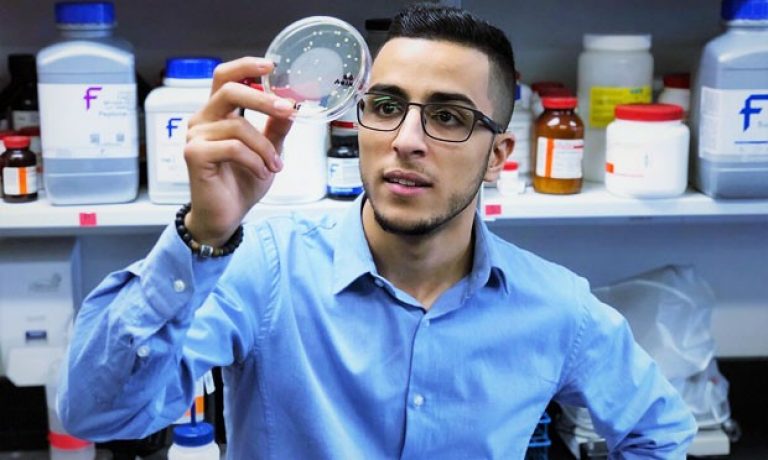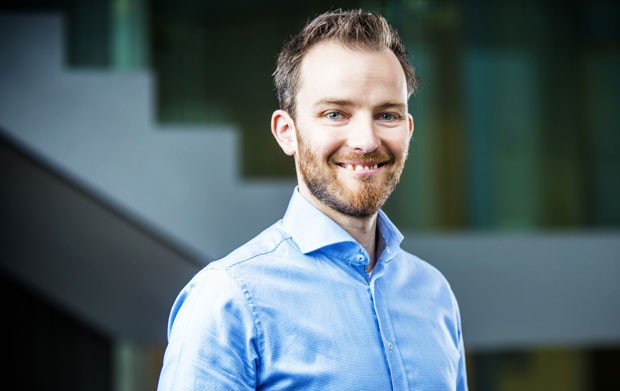These 2 one-minute videos by Montreal students are up for a national award

Two Concordians have been longlisted for the Science, Action! video competition – and they need your help to advance to the next round.
The competition, hosted by the Natural Sciences and Engineering Research Council of Canada (NSERC), showcases short videos about science and engineering research.
The Concordians in the running are Younes Medkour, a PhD candidate in the Department of Biology, and Lucas Hof, a PhD student from the Department of Mechanical, Industrial and Aerospace Engineering. In order to stay in the competition, Medkour and Hof need you to watch, champion and share their one-minute videos.
The 25 videos with the most views by March 2 will make the final round. The 15 finalists, chosen by a panel of judges, will win cash prizes and be featured as part of museum exhibits and science fairs, and during Science Odyssey and Science Literacy Week.
Medkour’s video “The Fountain of Youth” features his aging research and his quest to increase the human lifespan and delay the onset of age-related diseases. Medkour has discovered that white willow bark extract can extend longevity in baker’s yeast. This has potential significance for human aging, given the similarities between human cells and yeast.
Hof’s video, “Manufacturing the Future,” features the glass micro-machining technology he has developed alongside his colleagues at Concordia’s Electrochemical Green Engineering (EGE) Group.
The new technology could transform the way products that use delicate materials such as glass are produced on a mass scale. Hof’s video also features animations by Ruiting Ji, a third-year student at the Mel Hoppenheim School of Cinema.
Younes Medkour: ‘This research affects everyone’
How did you first become interested in the research project showcased in your “Fountain of Youth” video?
YM: I always took aging for granted and never thought that it could be studied. Aging research sounded like fiction to me until I realized that Concordia had researchers working on this mystery. That’s when I applied to Vladimir Titorenko’s laboratory for an undergraduate volunteer researcher position. I have been hooked ever since.
Why is this research important and who does it affect?
YM: Have you ever heard of someone who doesn’t age? No, right! This research affects everyone, because everyone grows old. And with the increasing numbers of elderly people, new challenges arise. My research is aimed at the discovery of natural chemical molecules that can delay aging, improve the health of elderly people and slow down the onset of age-related disorders like arthritis, diabetes, heart disease, liver dysfunction, cancer, sarcopenia and neurodegenerative diseases.
What is the desired outcome of your research?
YM: The hope is to develop new types of natural products of plant origin that delay aging and improve health. This research will also expand our understanding of the biology of aging, which is fundamental to curing age-related disorders.
We have identified that white willow bark has age-slowing properties in yeast, and this could potentially apply to humans. Because this natural extract is a mixture of many molecules, I’m also participating in research aimed at identifying the specific molecule or mixture of molecules responsible for delaying aging.
What inspired you to apply for this contest?
YM: As a researcher, one of my duties is to inform the public of the progress of my field. And since I really enjoy talking about my research, I thought this was a good way to showcase what I was working on.
 Lucas Hof, a PhD student from the Department of Mechanical, Industrial and Aerospace Engineering.
Lucas Hof, a PhD student from the Department of Mechanical, Industrial and Aerospace Engineering.
Lucas Hof: ‘Everyone is talking about smart manufacturing’
How did you first become interested in the research project showcased in your “Manufacturing the Future” video?
LH: I finished my master’s in mechanical engineering in 2004, specializing in advanced mechatronics. I then worked for 10 years in 3D printing – also known as additive manufacturing.
I became aware of the shortcomings of metal 3D printing. At the end of the 3D printing process, the metal was too rough. People in the aerospace and biomedical industries would therefore have to post-process those parts for real use in applications.
I decided to go back to research after 10 years of working, since I really like the academic research environment and helping push the limits of technology in order to develop new applications and new technologies, and to do things that aren’t yet possible.
Why is this research important and who does it affect?
LH: In Quebec, and in Canada, everyone is talking about “Industry 4.0,” or smart manufacturing. More and more people want custom objects — furniture, shoes, cell phones — and industry has to fulfil these needs on a mass scale.
The major challenge for industry is to make this transformation happen in their current facilities. Our aim is to support this transition by developing novel flexible manufacturing methods and approaches, and preparing future engineers for this new Industry 4.0 manufacturing paradigm.
The electrochemical processing technology that my team at the EGE Group has developed allows the tiny glass parts needed for these custom objects to be shaped and worked on without them having to come into contact with any tools or clamps.
Because of this, manufacturers will no longer have to change the whole environment of their machine to adapt it for each new piece, and their overheads will be lower. This will make it cheaper to mass-produce unique products.
What is the desired outcome of your research?
LH: We hope to make the mass production of individualized components for manufacturing cheaper, whether it’s for the watch industry, the aerospace industry or the biomedical industry.
For example, the biomedical industry often requires custom-made or small series devices on glass, such as a lab-on-a-chip. Our technology will allow these glass parts to be created cheaply on a mass scale while still being individualized.
Also, countries like Canada and the US are investing a lot to get manufacturing jobs back in their countries. This type of high-level technology will also attract manufacturing and labour back to high-wage countries instead of it being outsourced to low-wage countries for low-wage skilled jobs.
What inspired you to apply for this contest?
LH: I already had a two-minute version of the video, so it didn’t take too long to shorten it up and enter it into the competition! Back in November, I worked with the amazing Ruiting Ji on the longer version for Concordia’s In Focus video series, which showcased the work of Concordia graduate student researchers through the lens of filmmakers from the Mel Hoppenheim School of Cinema.
The amazing look of the video: that’s not me, that’s her. We talked about the concept and what could be included. I narrated it and wrote the story, but she made all the animations.
The competition is a really good opportunity to show your research to the world.
Watch and share the videos by Concordians Younes Medkour and Lucas Hof:
Find out more about NSERC’s Science, Action! competition.



